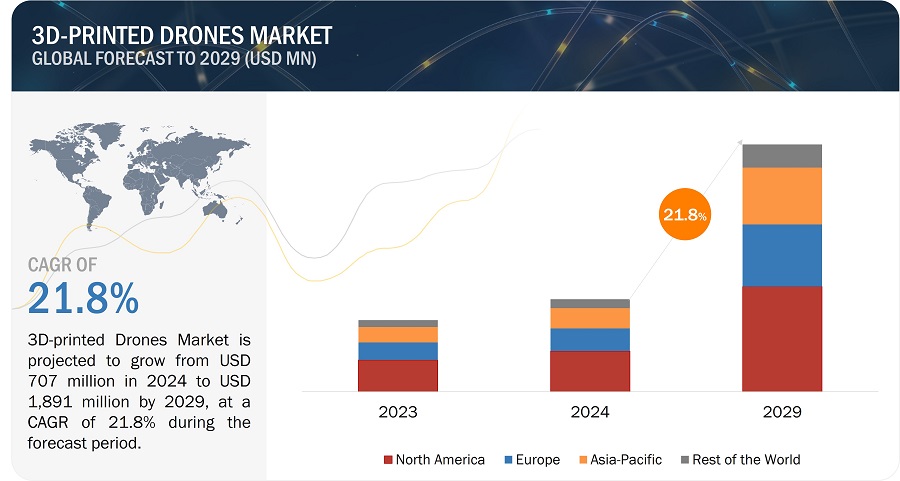The report “3D-Printed Drones Market by Component (Frames & Arms, Propellers, Landing Gears, Wing Structures, Mounts & Holders, Enclosures), Type (Fixed-wing, Rotary-wing, Hybrid), Platform, Application, Manufacturing Technique and Region – Global Forecast to 2029” The 3D-printed drones market is projected to grow from USD 707 million in 2024 to USD 1,891 million by 2029, at a CAGR of 21.8% from 2024 to 2029. The market growth can be attributed to the growing utilization of 3D printing technology for rapid prototyping and improved customization.
Download PDF Brochure @ https://www.marketsandmarkets.com/pdfdownloadNew.asp?id=50528178
Browse 192 market data Tables and 77 Figures spread throug 227 Pages and in-depth TOC on “3D-Printed Drones Market”
View detailed Table of Content here – https://www.marketsandmarkets.com/Market-Reports/3d-printed-drone-market-50528178.html
Significant advances in additive manufacturing, with rapid prototyping, inexpensive production, and fabrication of complex lightweight structures, are driving the market for 3D printed drones. The ability to produce custom components on demand also reduces inventory costs and fast design -Facilitates iteration. This flexibility is particularly useful for the military because some operations require more specialized drones. However, operational complexity is further increased by the need for skilled workers and designers coupled with the high initial cost of 3D printers and sophisticated components and mechanical capacity limitations for 3D printed parts to prevent them. Despite these limitations, innovative applications such as customized delivery systems and environmental monitoring provide attractive improvements. Advances in 3D printing materials and techniques have expanded the possibilities of 3D printed drones. The key players in the 3D-printed drones’ market are Boeing (US), AeroVironment, Inc. (U.S.), Parrot Drone SAS (France), General Atomics (U.S.), and Skidoo, Inc. (U.S.)
Based on component, frames & arms segment dominate the market in the base year.
In terms of component, the 3D-printed drones market is divided into frames & arms, propellers, landing gears, wing structures, mounts & holders, enclosures, and other parts. An increasing demand for lightweight and durable structures is anticipated to drive the demand of frames & arms segment.
Advanced composites with equivalent strength and weight, such as polymers reinforced with carbon fiber, are now viable due to advancements in 3D printing technology. This is particularly critical for drone weaponry and frames, as the use of lighter materials enhances battery life, flight efficiency, and payload capacity. Furthermore, 3D printing offers significant advantages in customization and design flexibility, which are often restricted by the high tooling costs and design complexities of traditional manufacturing methods. The capability to swiftly fabricate intricate geometries without the need for costly molds or extensive assembly lines allows manufacturers to develop bespoke frames and components tailored to specific applications. This rapid prototyping facilitates quick testing of new designs and the rapid development of innovative ideas, enabling companies to promptly respond to market demands and maintain a competitive edge in the fast-evolving drone market.
Based on type, the fixed-wing drones is estimated to register a large share in the base year.
The 3D-printed drones market is categorized by type into fixed-wing drones, rotary-wing drones, and hybrid drones.
An advantage of 3D printing over conventional drone manufacturing technology to boost the development of fixed wing drones. Fixed-wing drones manufactured using additive manufacturing technology represent a significant improvement over conventional fixed-wing drones. This innovative approach enables rapid prototyping, cost-effectiveness and scalability, with consequences resulting in lighter, more powerful and more efficient drones. Key players such as AeroVironment, Inc. (US) and senseFly (Switzerland) are using 3D printing to produce fixed-side models that offer high performance for remote sensing, environmental monitoring and precision agricultural applications
The Asia Pacific region is projected to be a high growth potential market for 3D-printed Drones during the forecast period.
The Asia Pacific market is projected to witness a significant CAGR from 2024 to 2029. The region is witnessing a rapid adoption of 3D printing technology for drone manufacturing, driven by technological advancements and strong government support. China leads the 3D-printed drones’ market, subject to the presence of leading commercial drones and associated drone part manufacturers. In India, initiatives such as Make in India promote domestic innovation in 3D-printed drones. Meanwhile, Japan integrates 3D printing with robotics and AI for industrial applications. Australia’s aerospace sector, supported by government initiatives, utilizes 3D printing for environmental monitoring. South Korea’s focus on Industry 4.0 sees firms exploring advanced materials and 3D printing for enhanced drone capabilities in surveillance and delivery services. Overall, the region’s dynamic market scenario for 3D-printed drones is characterized by robust growth driven by technological innovation, government support, and a strong focus on both defense and commercial applications.
The major players include Boeing (US), Parrot Drone SAS (France), General Atomics (US), and AeroVironment, Inc. (US), among others.
Media Contact
Company Name: MarketsandMarkets™ Research Private Ltd.
Contact Person: Mr. Rohan Salgarkar
Email: Send Email
Phone: 18886006441
Address:1615 South Congress Ave. Suite 103
City: Delray Beach
State: FL 33445
Country: United States
Website: https://www.marketsandmarkets.com/Market-Reports/3d-printed-drone-market-50528178.html
Press Release Distributed by ABNewswire.com
To view the original version on ABNewswire visit: 3D-Printed Drones Market worth $1,891 Million by 2029, at a CAGR of 21.8%

